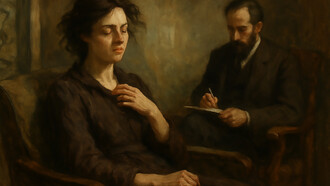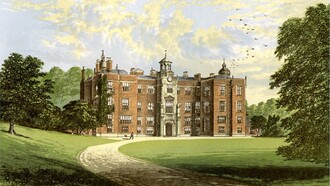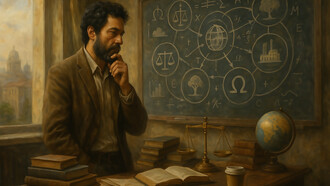In this interview, Dr. Isaac Amon delves into the intriguing history of the 1650s and 1660s, shedding light on pivotal events and figures. He also discusses the remarkable role of Sephardic Jews in colonial America, their contribution to the concept of religious freedom, and the impact of the Holocaust on Sephardic communities. Dr. Amon's insights offer a unique perspective on the historical tapestry of Sephardic history and its enduring significance.
The 1650s/1660s are a fascinating period in Sephardic and world history. What happened?
The mid-17th century witnessed a significant interplay of historical events. In the immediate aftermath of the Thirty Years War in Europe, history was forever changed. Rabbinic Judaism was challenged by scepticism and messianism—consequences of the Iberian Converso mentality—by Baruch Spinoza and Sabbetai Zevi. The former, for advancing extremely heterodox views on the nature of the divine and doubting the traditional claim of Mosaic authorship of the Pentateuch, was excommunicated by the Amsterdam Rabbinate. It remains in effect to this day. The latter, a messianic claimant from Izmir, Turkey, roiled Jewish and world affairs. Initially supported by Jewish communities across Europe and the Ottoman Empire, he later abrogated traditional Jewish laws and holidays. Under threat of death, he converted to Islam but continued to secretly practice some Jewish rituals. Most Jews renounced Zevi but some of his supporters followed him, becoming known as “donmeh.” A small number still exist today.
In England, the Amsterdam-based Rabbi Menasseh Ben Israel (born a Portuguese New Christian) met with Oliver Cromwell, Lord Protector of the Commonwealth. English Jewry, in the first national expulsion of a Jewish population, had been expelled by King Edward I in 1290. Iberian conversos nonetheless arrived and dwelled in the British Isles; in the 1540s, a small crypto-Jewish community appears to have resided in Bristol (led by Henriques Nunes); William Annyas was Mayor of Youghal in County Cork in the 1550s; and Rodrigo Lopes served as physician to Queen Elizabeth I in the 1580s (before he was hanged, drawn, and quartered on charges of treason). Ben Israel petitioned Cromwell to officially permit Jews to return. Cromwell tacitly allowed them to do so. They founded the Spanish and Portuguese congregation in 1657 and moved to a formal building in 1701 (Bevis Marks), which it inhabits to this day. It is the only synagogue in Europe, and likely the world, that has held regular services for more than 300 years.
In the New World, conversos (and crypto-Jews) accompanied Christopher Columbus on his first voyage across the Atlantic in 1492. Prominent among them was the translator, Luis de Torres. The Portuguese, under Pedro Alvares Cabral, discovered Brazil in 1500. Over succeeding decades and centuries, they came to Spanish and Portuguese colonies, fleeing inquisitorial persecution (regardless of adherence to crypto-Jewish practices and beliefs). They settled across these newly claimed lands, which extended from New Spain (Colonial Mexico and even parts of the future United States) to the Caribbean and South America.
In the 1620s, the Dutch conquered the Portuguese-administered city of Recife in northeastern Brazil. As crypto-Jews were now permitted to openly practice Judaism, they created Kahal Zur Israel, the first synagogue in the Americas. Amsterdam sent resources and personnel to assist the community, including Isaac Aboab da Fonseca (1605–1693), who served as the Rabbi there for over a decade (1642–1654). He is thus the first rabbi in the history of the Western Hemisphere. Following Portugal’s reconquest of Recife in 1654, many Jews returned to Europe, including Aboab. Others “island hopped” across the Caribbean (Jamaica, Curacao, Barbados, and Suriname) or moved further into the Brazilian sertão (Hinterland). A group of 23 Jews landed on the shores of New Amsterdam (renamed New York in 1664 when England captured the city), where their admission was stridently opposed by Peter Stuyvesant, the Director-General of the colony. Nonetheless, the Dutch West India Company, which controlled the colony, ordered the Jewish refugees to be admitted and to have the right to worship, though discrimination existed. They established Congregation Shearith Israel, which endures to this day. The arrival in 1654 traditionally marks the genesis of American Jewish history.
Aboab returned to Amsterdam, where he became Hakham, or Chief Rabbi; he participated in the excommunication of Spinoza in 1656, but ten years later, he supported the messianic claims of Sabbetai Zevi. Inaugurating the Portuguese synagogue, or Esnoga, in 1675, he died in 1693, having been a leading participant in these key 17th-century events that continue to influence the world we live in.
The Congregation Shearith Israel (often called the Spanish and Portuguese Synagogue of New York), established in 1654, is the oldest Jewish congregation in the United States. Can you speak more on the history of Jews in colonial America and the early United States?
Conversos (many of whom were crypto-Jews) arrived in the Americas alongside Christopher Columbus. Their migration continued. As early as 1565, conversos were likely present at the founding of St. Augustine, Florida, the oldest continuously inhabited city in the continental United States. By the 1590s, during the Oñate expedition along the Camino Real, conversos crossed the Rio Grande and settled across the American Southwest. Today, the region is learning more about this history in the borderlands, and in many cases, people are embracing their Jewish ancestry and heritage; some are even formally returning to Judaism. This was the main theme at the 33rd annual conference (August 2023) of the Society for Crypto-Judaic Studies in El Paso, Texas, where I was the emcee.
On the Eastern Seaboard of North America, Portuguese Jews arrived at the port cities of New York; Newport, Rhode Island; Philadelphia, Pennsylvania; Charleston, South Carolina; and Savannah, Georgia. Spanish and Portuguese synagogues and communities were founded, which are active congregations to this day. Jews had a direct connection to the colonies and the founding of the early United States. They represent an incredible (and quite literal) journey from extraordinary spiritual tyranny to freedom. Indeed, many of these arrivals (or their parents) had directly experienced inquisitorial persecution and terror.
Among these notable individuals were Dr. Samuel Nunes Ribeiro, a physician to the Portuguese Inquisitor General who fled to London and then Savannah, saving the colony from plague; Gershom Mendes Seixas, the spiritual leader of Congregation Shearith Israel in NYC and Mikveh Israel in Philadelphia, who ardently supported the American Revolution and who participated in the inauguration of America’s first President George Washington in 1789; and Aaron Lopez of Newport, a merchant, philanthropist, and slave owner who was born a Catholic in Portugal and arrived in Rhode Island as a young man where he reclaimed his ancestral Jewish identity and helped to establish the Touro Synagogue, which is the only colonial era synagogue building in the USA.
Religious toleration was already embedded in some of the British and Dutch colonies in the New World, building on the increasingly adopted idea of liberty of conscience. Roger Williams of Rhode Island, William Penn of Pennsylvania, and James Oglethorpe of Georgia welcomed religious minorities (including Jews). They believed, as Roger Williams emphatically phrased it near the end of his life that “forced worship stinks in God’s nostrils.” Colonel Mordechai Sheftall (son of Benjamin and Perla, two original [Ashkenazi] arrivals in 1733) became the highest-ranking Jewish officer in the Continental Army. When I was the guest speaker at the 290th anniversary of Congregation Mickve Israel in Savannah this past July, I was privileged to visit the cemetery and pay respects to this great man. His descendants still live in the city today.
Jonas Philips, a merchant, Revolutionary War veteran, and President of Philadelphia’s Mikveh Israel Congregation, was the husband of Rebecca Mendes Machado. Her maternal grandfather was Dr. Samuel Nunes of Savannah. Her mother, Zipporah, was a young lady when the Nunes family was imprisoned and their property confiscated; Zipporah would live to 85, dying in 1799, the same year as George Washington. Philips, her son-in-law, sent the only private petition to the Constitutional Convention in the summer of 1787. In the letter addressed to George Washington, Philips requested that the new Constitution enshrine religious freedom for Jews and, by implication, all minorities. While the delegates had already prohibited religious tests for federal office, Philips’ letter arguably symbolized Jewish trust in the nascent Republic and the country’s acceptance of open Jewish life. Upon Washington’s inauguration, all Spanish and Portuguese synagogues wrote letters to him; Savannah was the first. The President responded to each one of them, assuring all of America’s strong fidelity to religious freedom, as he did to other places of worship as well.
In his reply to the Touro Synagogue (addressed to Moses Seixas, brother of Shearith Israel’s minister Gershom), Washington wrote that “all possess alike liberty of conscience... It is now no more that toleration is spoken of, for, happily, the Government of the United States... gives to bigotry no sanction, to persecution no assistance. May the children of the stock of Abraham who dwell in this land continue to merit and enjoy the good will of the other inhabitants, while every one shall sit in safety under his own vine and fig tree, and there shall be none to make him afraid.” The founding commitment to religious freedom remains extraordinary, even from a 21st-century perspective. While struggles remained and prejudice did not vanish (sadly, it still remains), Jews have played a key role in the ongoing story of religious freedom in America.
What was the impact of the Holocaust on the Sephardic world?
Traditional knowledge of the Holocaust, or Shoah—the systematic state-sponsored persecution and murder of European Jewry by Nazi Germany and its collaborators—has long focused on Ashkenazi Jews. By numbers, they bore the brunt of the destruction (for example, 3.3 million Jews lived in Poland before World War II, whereas only 350,000 survived for a survival rate of 10 percent). Nonetheless, Sephardic communities were devastated as well, ranging from Amsterdam and France to Greece and the Balkans. Communities across North Africa (Morocco, Tunisia, Algeria, and Libya) were impacted by Nazi antisemitism as well; they were only saved due to the 1942 Allied advance (“Operation Torch”).
Perhaps the greatest Nazi destruction of a Sephardic community was that of Salonica, or Thessaloniki in Greek, the great port city on the shores of the Aegean Sea in Southeastern Europe. Dated to the 1st century CE (indeed, the Book of Acts even records that the Apostle Paul [formerly Saul of Tarsus] preached in the main synagogue on three consecutive Shabbats, or Saturdays), the already ancient Jewish community was transformed by the arrival of Iberian Jews fleeing the 1492 Edict of Expulsion, or Alhambra Decree. Followed by successive waves over subsequent decades and centuries, Salonika became known as the Jerusalem of the Balkans and the Mother of Israel (“Madre de Israel”) in Ladino. Controlled by the Ottoman Empire from 1430–1912, the city became a cosmopolitan entrepot where religions, nationalities, and ideas crisscrossed.
Sephardic Jews prospered spiritually, culturally, and commercially. In the 19th century, the community underwent modernization (as occurred across the Ottoman Empire) but emerged intact; as the 20th century dawned, Ladino was the city’s lingua franca, nearly half of the city was Jewish, and the port even closed on Shabbat. There were the Matanoth Levyonim, the Torah UmLahah, the Allatini and Aboad orphanages, the Hirsch hospital, and the Modiano home for the elderly.
Following the Nazi arrival in April 1941, Jewish life was curtailed and eventually proscribed. Stripped of its cultural heritage and forced into ghettos, the Jewish community witnessed the destruction of their 500-year-old cemetery, which contained 350,000 graves across 80 football fields. The Aristotle University sits atop its ruins today. From March to August 1943, the Nazis shipped nearly the entire population—in 19 convoys carrying around 2,500 men, women, and children every few days —by rail across the Balkans to Auschwitz-Birkenau where they almost all perished in the gas chambers, thus ending four and a half centuries of a vibrant Sephardic presence. A tiny minority survived inside Greece. Of a 50, 000 strong population in 1941, less than 4 percent, or 2,000 Salonikan Jews survived, including Moise and Sara Bourla, the parents of Albert, the current CEO of Pfizer. While the Jerusalem of the Balkans and Madre de Israel lasted for 450 years, the Nazi annihilation took 30 months. The glory that was Jewish Greece and the grandeur that was Jewish Salonika live on only in memory. It is estimated that the Nazis murdered up to 50 percent of Sephardic Jews in Europe. A Ladino verse expresses the utter magnitude of the calamity: “I would like to write my remembrances, but I would need a sea of ink and a sky for the paper.”
As a lawyer with a doctorate and a former legal fellow at the International Criminal Tribunal for the Former Yugoslavia in The Hague, research assistant to the ICC Special Adviser on Crimes against Humanity, and legal/investigative analyst of ISIS atrocities, teaching the Holocaust (including its horrific impact upon Sephardic Jewry) is vital. I was privileged to also have met Benjamin Ferencz, the last living Nuremberg prosecutor, who, at age 27, prosecuted the Einsatzgruppen—the SS death squads—who murdered a million Jews in the “Holocaust by Bullets.” In December 2022, he was awarded the Congressional Gold Medal for his “service to the United States and international community during the post-World War II Nuremberg trials and lifelong advocacy for international criminal justice and rule of law.” In April 2023, he passed away at the age of 103.
What more is in your future in teaching the world about the history of Sepharad?
As JHA Director of Academic Research, I speak on this legacy to conferences, communities, universities, and museums. As a lawyer, lecturer, and an adjunct professor at Washington University School of Law in St. Louis, I try to incorporate my study of Sepharad (e.g., heresy, inquisition and confession, expulsion and migration routes and networks, tangible and intangible cultural heritage, identity in medieval and early modern worlds, the relationship of Jewish history to the human story) into interviews, classes, discussions, and presentations to professional and lay audiences alike.
In addition, my family history inspires me to talk on this saga as my paternal grandparents of blessed memory, Dr. Rene Isaac Amon (from Istanbul, Turkey) and Mrs. Denise Safra Nahmad (from Aleppo, Syria, and Beirut, Lebanon), showed me Sephardic culture, heritage, and ethos yet also taught me to be at home amongst the Jewish world and others who have different religions, cultures, languages, foods, and music. This is part of the extraordinary diversity that constitutes the mosaic of the human race. I thus owe it to my ancestors to uphold this legacy for posterity, for Sephardic history is Jewish history, and Jewish history is truly world history.
Ultimately, as generational links in the chain of transmission, the importance of preserving this heritage was best summarized by the late Lord Rabbi Jonathan Sacks, the former Chief Rabbi of the United Kingdom (and a man I once had the honour to meet). As he eloquently wrote, “We did not come from nowhere, nor does our story end with us. We are chapters in a long and still-being-written story, a letter in the scroll of the book of the people of the book. Take it, cherish it, learn to understand and to love it. And may you in turn pass it on to future generations. For you are a member of an eternal people, a letter in their scroll. Let their eternity live on in you.”















